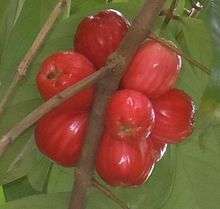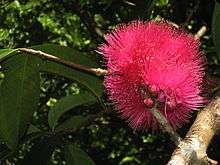Syzygium malaccense
Syzygium malaccense is a species of flowering tree native to Malesia and Australia.[1][2] It is one of the species cultivated since prehistoric times by the Austronesian peoples. They were carried and introduced deliberately to Remote Oceania as canoe plants. In modern times, it has been introduced throughout the tropics, including many Caribbean countries and territories.[3][4][5]
| Malay (rose) apple | |
|---|---|
 | |
Rare (NCA) | |
| Scientific classification | |
| Kingdom: | Plantae |
| Clade: | Tracheophytes |
| Clade: | Angiosperms |
| Clade: | Eudicots |
| Clade: | Rosids |
| Order: | Myrtales |
| Family: | Myrtaceae |
| Genus: | Syzygium |
| Species: | S. malaccense |
| Binomial name | |
| Syzygium malaccense | |
| Synonyms[1] | |
| |
Names
Syzygium malaccense has a number of English common names. It is known as a Malay rose apple, or simply Malay apple, mountain apple, rose apple, Otaheite apple, pink satin-ash and pommerac (derived from pomme Malac, meaning "Malayan apple" in French).[1] Despite the fact that it is sometimes called the otaheite cashew, it is not related to cashew. While cashew nuts (but not cashew fruits) may trigger allergic reactions,[6][7] rose apple fruit has not been observed to do so.[8]
Description
The combination of tree, flowers and fruit has been praised as the most beautiful of the genus Syzygium.[9] The fruit is oblong-shaped and dark red in color, although some varieties have white or pink skins. The flesh is white and surrounds a large seed. Its taste is bland but refreshing. Jam is prepared by stewing the flesh with brown sugar and ginger.

Cultivation
Malay apple is a strictly tropical tree and will be damaged by freezing temperatures.[10] It thrives in humid climates with an annual rainfall of 152 cm (60 in) or more. It can grow at a variety of altitudes, from sea level up to 2,740 m (8,990 ft). The tree can grow to 12–18 m (39–59 ft) in height. It flowers in early summer, bearing fruit three months afterward. In Costa Rica, it flowers earlier, with ripe fruit in April. Coffee growers use the species to both divert birds and provide shade.
In Hawaii, Syzygium malaccense is called mountain apple. When the Polynesians reached the Hawaiian Islands, they brought plants and animals that were important to them. The mountain apple was one of these "canoe plants," arriving 1000–1700 years ago.[11]
Nutrition
The mountain apple is an edible fruit that can be consumed when raw and ripe. In Puerto Rico, the Malay apple is used to make wines, in Hawai'i, the fruits are consumed the same way a Pacific Northwest apple is eaten.[12] Indonesians consume the flowers of the tree in salads and in Guyana the skin of the mountain apple is cooked down to make a syrup.[13] A mountain apple has a white fleshy fruit that has a similar texture to a pear but less sweet than an apple. Below is a chart with more nutrition information derived from Malay apples found in Hawai'i, El Salvador, and Ghana. Due to the high water content, the Mountain Apple is lower in calories than a Gala apple or a Fuji apple and contains a moderate amount of vitamins and minerals.
| Food Value Per 100g of Edible Portion | |
|---|---|
| Moisture | 90.3-91.6 g |
| Protein | 0.5-0.7g |
| Fat | 0.1-0.2 g |
| Fiber | 0.6-0.8 g |
| Ash | 0.26-0.39 g |
| Calcium | 5.6-5.9 g |
| Phosphorus | 11.6-17.9 g |
| Iron | 0.2-0.82 g |
| Carotene | 0.003-0.008 mg |
| Vitamin A | 3-10 I.U. |
| Thiamine | 15-39 mcg |
| Riboflavin | 20-39 g |
| Niacin | 0.21-0.41 mg |
| Ascorbic Acid | 6.5- 17.0 mg |
History
In 1793, Captain William Bligh was commissioned to procure edible fruits from the Pacific Islands for Jamaica, including this species.[14]
Gallery
 Fruits
Fruits Buds
Buds- Fruits
 A ripened Syzygium malaccense whole.
A ripened Syzygium malaccense whole. A ripened Syzygium malaccense cut into half, showing the seed.
A ripened Syzygium malaccense cut into half, showing the seed.
References
- "Syzygium malaccense". Germplasm Resources Information Network (GRIN). Agricultural Research Service (ARS), United States Department of Agriculture (USDA). Retrieved 2009-11-20.
- Hyland, B. P. M.; Whiffin, T.; Zich, F. A.; et al. (Dec 2010). "Factsheet – Syzygium malaccense". Australian Tropical Rainforest Plants (6.1, online version RFK 6.1 ed.). Cairns, Australia: Commonwealth Scientific and Industrial Research Organisation (CSIRO), through its Division of Plant Industry; the Centre for Australian National Biodiversity Research; the Australian Tropical Herbarium, James Cook University. Retrieved 27 Nov 2014.
- Dotte-Sarout, Emilie (2016). "Evidence of forest management and arboriculture from wood charcoal data: an anthracological case study from two New Caledonia Kanak pre-colonial sites". Vegetation History and Archaeobotany. 26 (2): 195–211. doi:10.1007/s00334-016-0580-0.
- Whistler, W. Arthur; Elevitch, Craig R. (2006). "Syzygium malaccense (Malay apple) (beach hibiscus)". In Elevitch, Craig R. (ed.). Traditional Trees of Pacific Islands: Their Culture, Environment, and Use (PDF). Permanent Agricultural Resources (PAR). pp. 41–56. ISBN 9780970254450.
- Blench, Roger (2004). "Fruits and arboriculture in the Indo-Pacific region". Bulletin of the Indo-Pacific Prehistory Association. 24 (The Taipei Papers (Volume 2)): 31–50.
- Rance (2003). "Cashew allergy: observations of 42 children without associated peanut allergy". Allergy. 58 (12): 1311–1314. doi:10.1046/j.1398-9995.2003.00342.x.
- "Substance Info: Cashew Nut".
- "Substance Info: Rose-apple".
- Morton, Julia (1987). Fruits of Warm Climates. Florida Flair Books. p. 505. ISBN 978-0-9610184-1-2.
- "Malay Apple". Plant Characteristics. Pine Island Nursery.
- Whistler, W. Arthur (2009). Plants of the canoe people: an ethnobotanical voyage through Polynesia. National Tropical Botanical Garden. p. 241. ISBN 978-0-915809-00-4.
- Morton, Julia. Fruits of Warm Climates. Julia F. Morton. pp. 378–381. ISBN 0-9610184-1-0. Retrieved March 20, 2019.
- Morton, Julia. Fruits of Warm Climates. Julia F. Morton. pp. 378–381. ISBN 0-9610184-1-0. Retrieved March 20, 2019.
- Hargreaves, Dorothy; Hargreaves, Bob (1964). Tropical Trees of Hawaii. Kailua, Hawaii: Hargreaves. p. 45.
- "Malay Apple Syzygium malaccense a.k.a. Mountain Apple". Retrieved 2006-08-18.
| Wikimedia Commons has media related to Syzygium malaccense. |